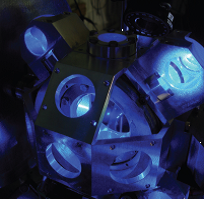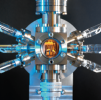The SI unit of time, the second, is currently defined in terms of the frequency of the microwave transition between the two ground state hyperfine levels of the 133Cs atom. However the most advanced optical atomic clocks have now reached levels of stability and accuracy that significantly surpass the performance of the best caesium primary standards. As a result, the possibility of a future redefinition of the second is being considered by the international metrology community.

Our project tackled some of the key challenges that must be addressed before such a redefinition can be implemented. Our main objectives were to:
- Develop improved methods for comparing optical clocks developed in different laboratories.
- Carry out a coordinated programme of clock comparisons to validate the performance levels of the optical clocks, to anchor their frequencies as well as possible to the current definition of the second, and to establish the leading contenders for a redefinition of the second.
- Evaluate relativistic effects influencing comparisons between clocks at an improved level of accuracy, including the gravitational redshift of the clock transition frequency.
- Establish a framework and procedures for the optical clocks to be integrated into international timescales.
The key results and conclusions of our research are as follows:
- We have carried out a comprehensive set of local frequency comparisons between high accuracy optical clocks in European national measurement institutes (NMIs). This includes both direct optical frequency ratio measurements and absolute frequency measurements relative to primary caesium standards.
- Using a broadband version of two-way satellite time and frequency transfer (TWSTFT), we have carried out by far the most extensive remote optical clock comparison campaign ever performed, achieving link uncertainties in the low parts in 1016 range. This is approximately an order of magnitude better than achieved using the standard TWSTFT currently used to compare microwave atomic clocks.
- The recently introduced GPS integer precise point positioning (IPPP) technique has been shown to have similar performance to broadband TWSTFT. It has the significant advantage that it is a considerably cheaper and more robust technique that can readily be put into regular operation.
- We have demonstrated the first functional transportable optical clock worldwide. This has achieved a better performance than any other mobile frequency standard, both in terms of instability and uncertainty.
- Relativistic effects affecting optical clock comparisons have been evaluated at the 10-18 level of accuracy, compatible with the projected uncertainties of the clocks. These effects include the gravitational redshift of the clock transition frequencies, which required an improved evaluation of the gravity potential at the European NMIs.
- A new European quasi-geoid model has been computed, incorporating new gravity measurements carried out at and around the NMI sites. This has unified the description of the geopotential for European NMIs and will also benefit the geodesy community.
- New methods and procedures have been developed for analysing over-determined sets of clock frequency comparison data. These methods were used by the CCL-CCTF Frequency Standards Working Group in September 2015 in updating the list of CIPM recommended frequency values.
- We have carried out a proof-of-principle experiment in which an optical clock was used to measure the gravity potential difference between two remote locations, demonstrating the future benefits that measurements of this type could bring to the geodesy community.
For more information, please contact the project coordinator, Dr Helen Margolis from NPL.

The research within this EURAMET joint research project receives funding from the European Community's Seventh Framework Programme, ERA-NET Plus, under Grant Agreement No. 217257.
News
ITOC final workshop:
The ITOC final workshop took place on Friday 8 April 2016 at the University of York, UK, in association with EFTF 2016
News article in Nature:
The 4 June 2015 edition of Nature includes a news story that discusses our experiment to compare optical clocks by broadband two-way satellite time and frequency transfer.

